Report on Natural Hazards and Climate Change Impacts in New York City
VerifiedAdded on 2022/09/18
|6
|1219
|22
Report
AI Summary
This report provides a comprehensive analysis of New York City's vulnerability to natural hazards and the impacts of climate change. The study highlights the city's susceptibility to various disasters, including coastal and inland flooding, heatwaves, hurricanes, and severe storms, and discusses the role of rising sea levels and extreme weather events. The report details the consequences of these hazards, such as transportation disruptions, building damages, and impacts on essential services like education and energy systems. Furthermore, it explores mitigation strategies, emphasizing the need for multidisciplinary approaches involving governmental bodies and environmental agencies. Proposed solutions include greening initiatives, sustainable development, infrastructure improvements, and disaster preparedness through public awareness and effective warning systems. The report concludes by stressing the importance of proactive measures to reduce the frequency and severity of natural disasters in NYC, considering the increasing population, economic development, and the associated rise in greenhouse gas emissions.
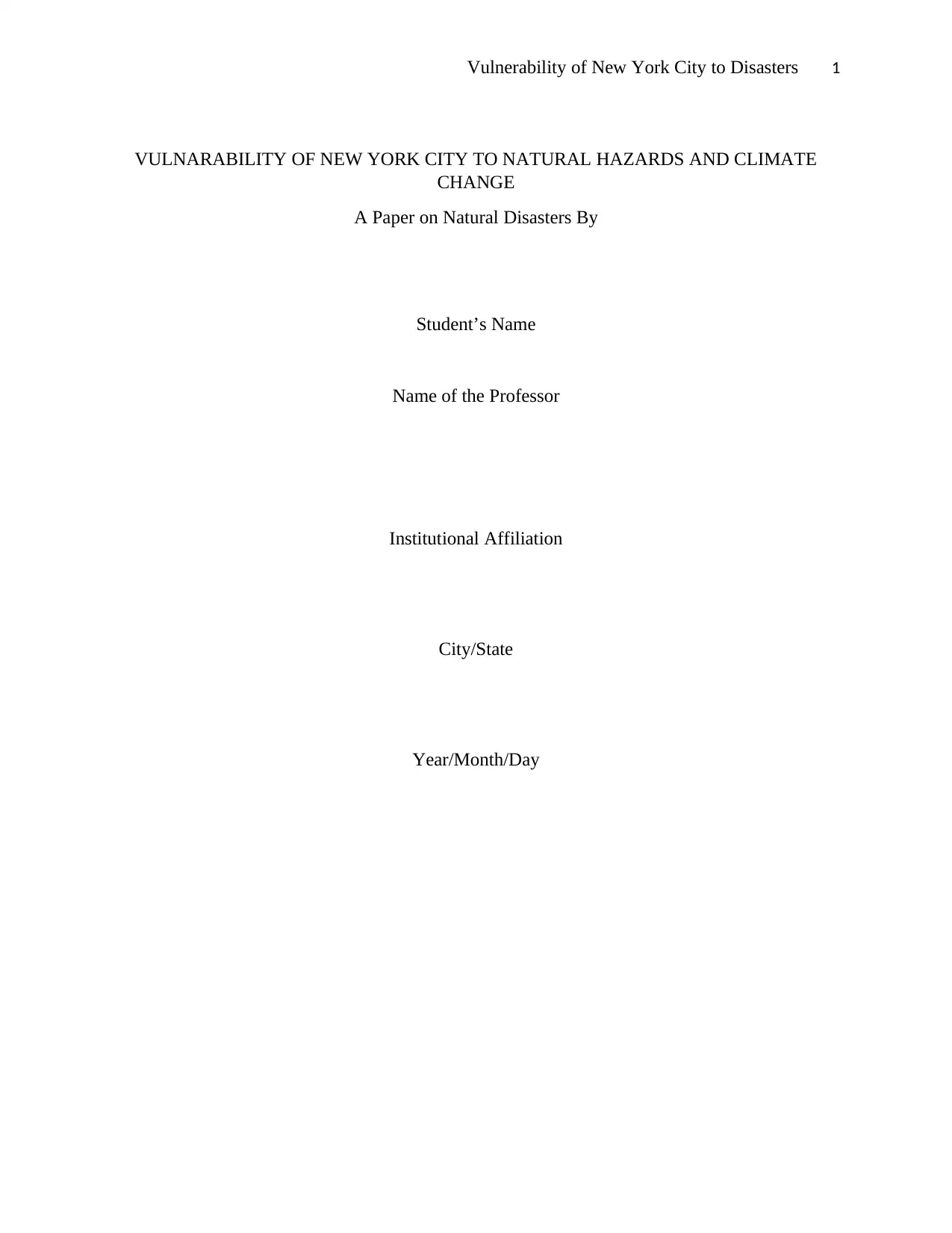
Vulnerability of New York City to Disasters 1
VULNARABILITY OF NEW YORK CITY TO NATURAL HAZARDS AND CLIMATE
CHANGE
A Paper on Natural Disasters By
Student’s Name
Name of the Professor
Institutional Affiliation
City/State
Year/Month/Day
VULNARABILITY OF NEW YORK CITY TO NATURAL HAZARDS AND CLIMATE
CHANGE
A Paper on Natural Disasters By
Student’s Name
Name of the Professor
Institutional Affiliation
City/State
Year/Month/Day
Paraphrase This Document
Need a fresh take? Get an instant paraphrase of this document with our AI Paraphraser
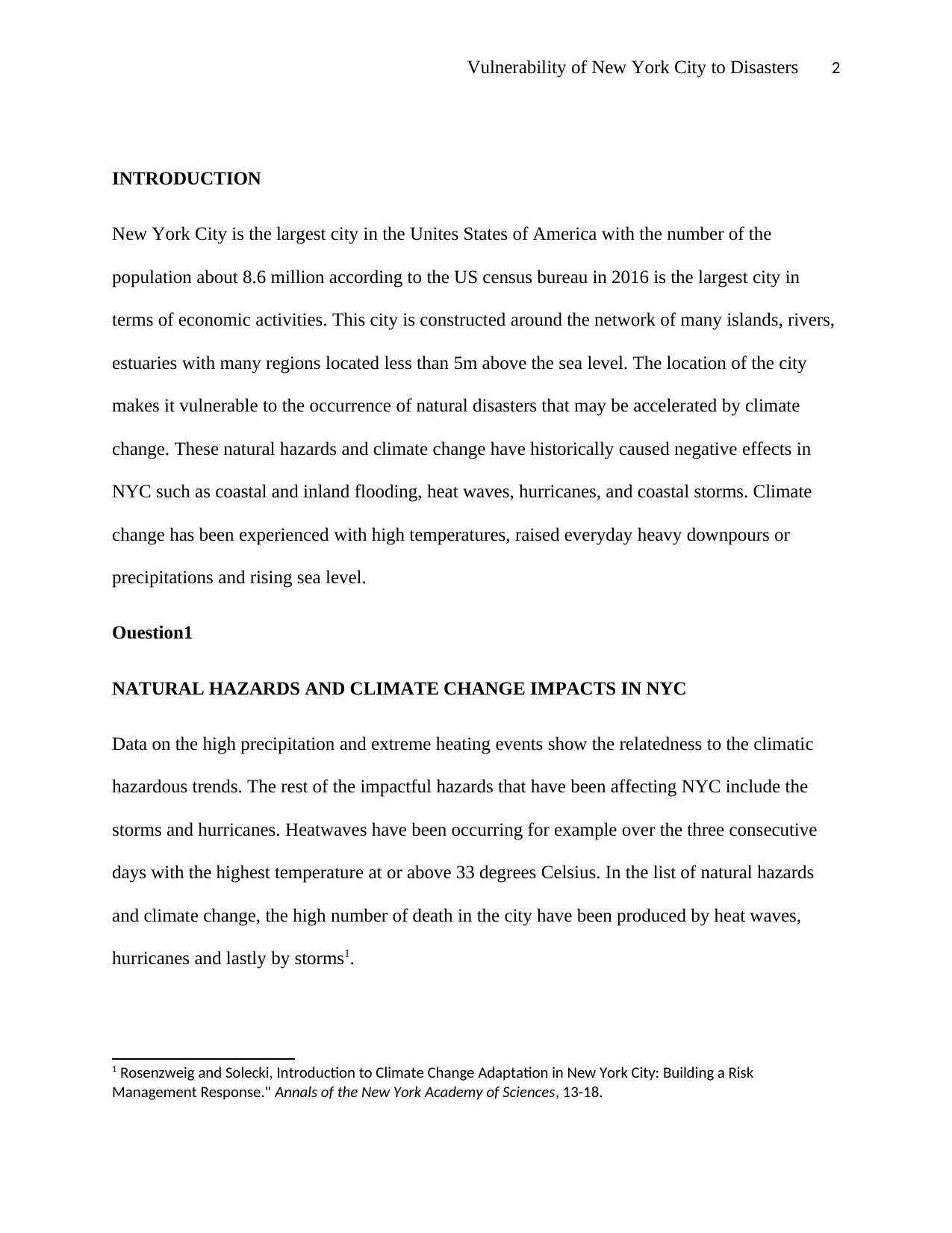
Vulnerability of New York City to Disasters 2
INTRODUCTION
New York City is the largest city in the Unites States of America with the number of the
population about 8.6 million according to the US census bureau in 2016 is the largest city in
terms of economic activities. This city is constructed around the network of many islands, rivers,
estuaries with many regions located less than 5m above the sea level. The location of the city
makes it vulnerable to the occurrence of natural disasters that may be accelerated by climate
change. These natural hazards and climate change have historically caused negative effects in
NYC such as coastal and inland flooding, heat waves, hurricanes, and coastal storms. Climate
change has been experienced with high temperatures, raised everyday heavy downpours or
precipitations and rising sea level.
Ouestion1
NATURAL HAZARDS AND CLIMATE CHANGE IMPACTS IN NYC
Data on the high precipitation and extreme heating events show the relatedness to the climatic
hazardous trends. The rest of the impactful hazards that have been affecting NYC include the
storms and hurricanes. Heatwaves have been occurring for example over the three consecutive
days with the highest temperature at or above 33 degrees Celsius. In the list of natural hazards
and climate change, the high number of death in the city have been produced by heat waves,
hurricanes and lastly by storms1.
1 Rosenzweig and Solecki, Introduction to Climate Change Adaptation in New York City: Building a Risk
Management Response." Annals of the New York Academy of Sciences, 13-18.
INTRODUCTION
New York City is the largest city in the Unites States of America with the number of the
population about 8.6 million according to the US census bureau in 2016 is the largest city in
terms of economic activities. This city is constructed around the network of many islands, rivers,
estuaries with many regions located less than 5m above the sea level. The location of the city
makes it vulnerable to the occurrence of natural disasters that may be accelerated by climate
change. These natural hazards and climate change have historically caused negative effects in
NYC such as coastal and inland flooding, heat waves, hurricanes, and coastal storms. Climate
change has been experienced with high temperatures, raised everyday heavy downpours or
precipitations and rising sea level.
Ouestion1
NATURAL HAZARDS AND CLIMATE CHANGE IMPACTS IN NYC
Data on the high precipitation and extreme heating events show the relatedness to the climatic
hazardous trends. The rest of the impactful hazards that have been affecting NYC include the
storms and hurricanes. Heatwaves have been occurring for example over the three consecutive
days with the highest temperature at or above 33 degrees Celsius. In the list of natural hazards
and climate change, the high number of death in the city have been produced by heat waves,
hurricanes and lastly by storms1.
1 Rosenzweig and Solecki, Introduction to Climate Change Adaptation in New York City: Building a Risk
Management Response." Annals of the New York Academy of Sciences, 13-18.
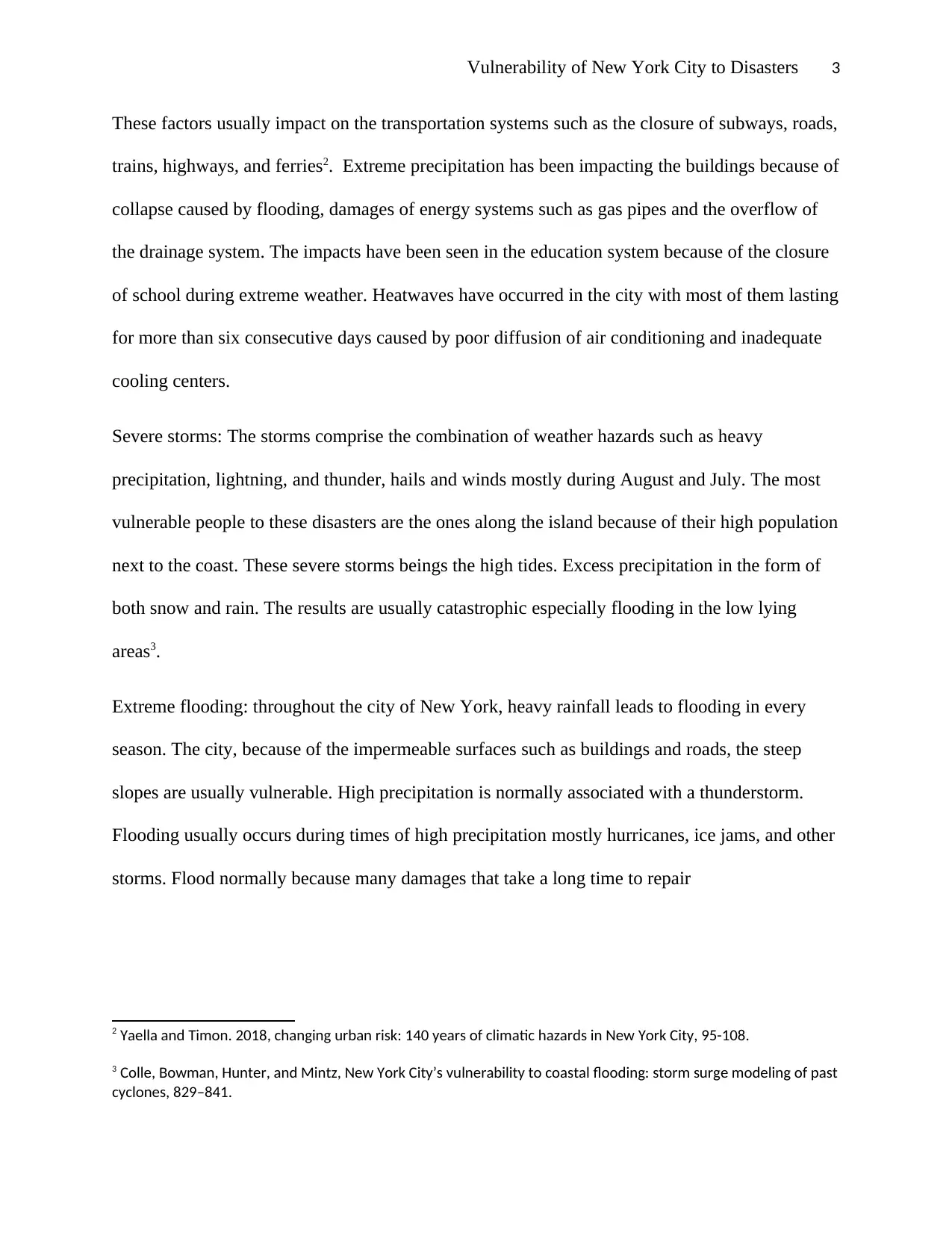
Vulnerability of New York City to Disasters 3
These factors usually impact on the transportation systems such as the closure of subways, roads,
trains, highways, and ferries2. Extreme precipitation has been impacting the buildings because of
collapse caused by flooding, damages of energy systems such as gas pipes and the overflow of
the drainage system. The impacts have been seen in the education system because of the closure
of school during extreme weather. Heatwaves have occurred in the city with most of them lasting
for more than six consecutive days caused by poor diffusion of air conditioning and inadequate
cooling centers.
Severe storms: The storms comprise the combination of weather hazards such as heavy
precipitation, lightning, and thunder, hails and winds mostly during August and July. The most
vulnerable people to these disasters are the ones along the island because of their high population
next to the coast. These severe storms beings the high tides. Excess precipitation in the form of
both snow and rain. The results are usually catastrophic especially flooding in the low lying
areas3.
Extreme flooding: throughout the city of New York, heavy rainfall leads to flooding in every
season. The city, because of the impermeable surfaces such as buildings and roads, the steep
slopes are usually vulnerable. High precipitation is normally associated with a thunderstorm.
Flooding usually occurs during times of high precipitation mostly hurricanes, ice jams, and other
storms. Flood normally because many damages that take a long time to repair
2 Yaella and Timon. 2018, changing urban risk: 140 years of climatic hazards in New York City, 95-108.
3 Colle, Bowman, Hunter, and Mintz, New York City’s vulnerability to coastal flooding: storm surge modeling of past
cyclones, 829–841.
These factors usually impact on the transportation systems such as the closure of subways, roads,
trains, highways, and ferries2. Extreme precipitation has been impacting the buildings because of
collapse caused by flooding, damages of energy systems such as gas pipes and the overflow of
the drainage system. The impacts have been seen in the education system because of the closure
of school during extreme weather. Heatwaves have occurred in the city with most of them lasting
for more than six consecutive days caused by poor diffusion of air conditioning and inadequate
cooling centers.
Severe storms: The storms comprise the combination of weather hazards such as heavy
precipitation, lightning, and thunder, hails and winds mostly during August and July. The most
vulnerable people to these disasters are the ones along the island because of their high population
next to the coast. These severe storms beings the high tides. Excess precipitation in the form of
both snow and rain. The results are usually catastrophic especially flooding in the low lying
areas3.
Extreme flooding: throughout the city of New York, heavy rainfall leads to flooding in every
season. The city, because of the impermeable surfaces such as buildings and roads, the steep
slopes are usually vulnerable. High precipitation is normally associated with a thunderstorm.
Flooding usually occurs during times of high precipitation mostly hurricanes, ice jams, and other
storms. Flood normally because many damages that take a long time to repair
2 Yaella and Timon. 2018, changing urban risk: 140 years of climatic hazards in New York City, 95-108.
3 Colle, Bowman, Hunter, and Mintz, New York City’s vulnerability to coastal flooding: storm surge modeling of past
cyclones, 829–841.
⊘ This is a preview!⊘
Do you want full access?
Subscribe today to unlock all pages.

Trusted by 1+ million students worldwide
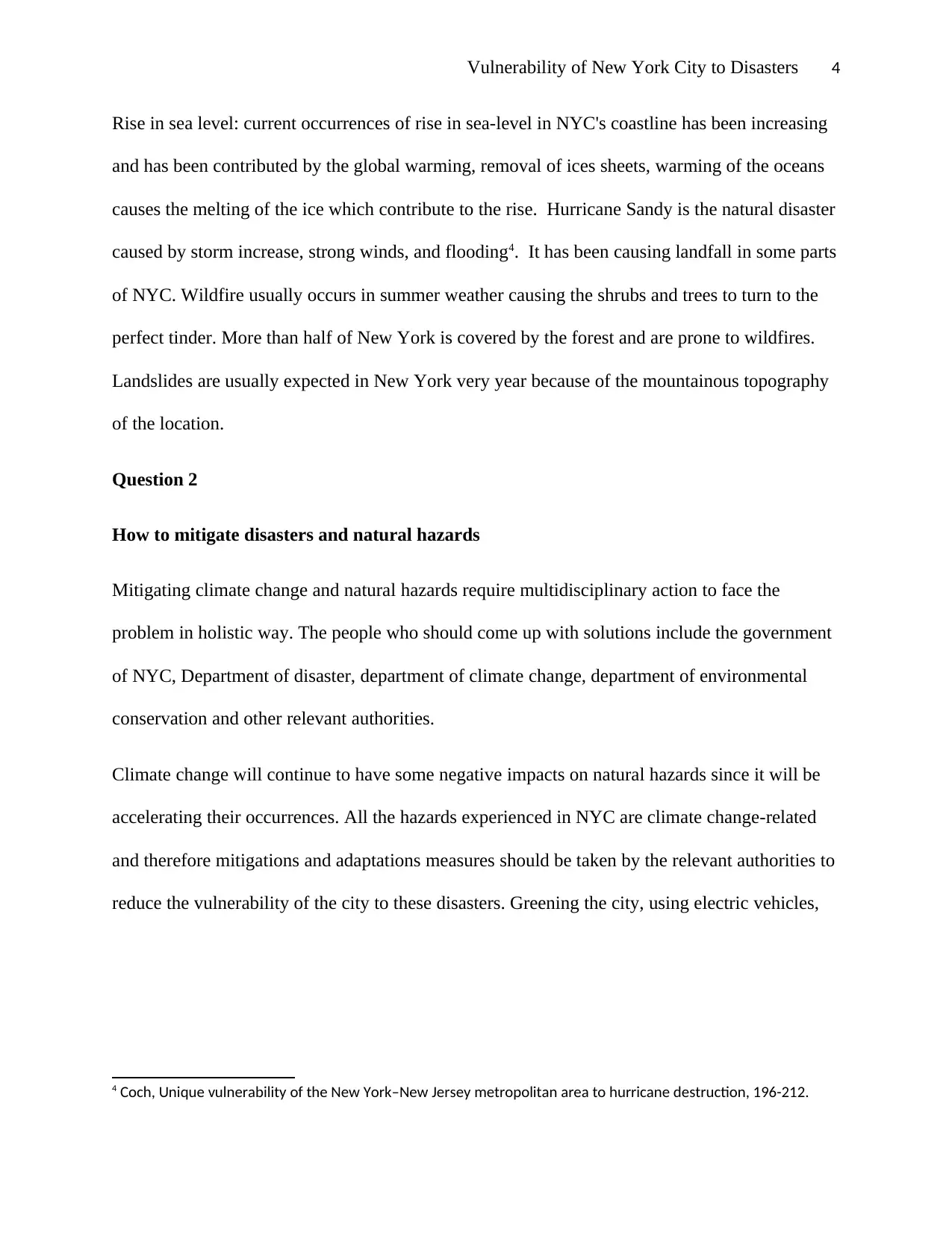
Vulnerability of New York City to Disasters 4
Rise in sea level: current occurrences of rise in sea-level in NYC's coastline has been increasing
and has been contributed by the global warming, removal of ices sheets, warming of the oceans
causes the melting of the ice which contribute to the rise. Hurricane Sandy is the natural disaster
caused by storm increase, strong winds, and flooding4. It has been causing landfall in some parts
of NYC. Wildfire usually occurs in summer weather causing the shrubs and trees to turn to the
perfect tinder. More than half of New York is covered by the forest and are prone to wildfires.
Landslides are usually expected in New York very year because of the mountainous topography
of the location.
Question 2
How to mitigate disasters and natural hazards
Mitigating climate change and natural hazards require multidisciplinary action to face the
problem in holistic way. The people who should come up with solutions include the government
of NYC, Department of disaster, department of climate change, department of environmental
conservation and other relevant authorities.
Climate change will continue to have some negative impacts on natural hazards since it will be
accelerating their occurrences. All the hazards experienced in NYC are climate change-related
and therefore mitigations and adaptations measures should be taken by the relevant authorities to
reduce the vulnerability of the city to these disasters. Greening the city, using electric vehicles,
4 Coch, Unique vulnerability of the New York–New Jersey metropolitan area to hurricane destruction, 196-212.
Rise in sea level: current occurrences of rise in sea-level in NYC's coastline has been increasing
and has been contributed by the global warming, removal of ices sheets, warming of the oceans
causes the melting of the ice which contribute to the rise. Hurricane Sandy is the natural disaster
caused by storm increase, strong winds, and flooding4. It has been causing landfall in some parts
of NYC. Wildfire usually occurs in summer weather causing the shrubs and trees to turn to the
perfect tinder. More than half of New York is covered by the forest and are prone to wildfires.
Landslides are usually expected in New York very year because of the mountainous topography
of the location.
Question 2
How to mitigate disasters and natural hazards
Mitigating climate change and natural hazards require multidisciplinary action to face the
problem in holistic way. The people who should come up with solutions include the government
of NYC, Department of disaster, department of climate change, department of environmental
conservation and other relevant authorities.
Climate change will continue to have some negative impacts on natural hazards since it will be
accelerating their occurrences. All the hazards experienced in NYC are climate change-related
and therefore mitigations and adaptations measures should be taken by the relevant authorities to
reduce the vulnerability of the city to these disasters. Greening the city, using electric vehicles,
4 Coch, Unique vulnerability of the New York–New Jersey metropolitan area to hurricane destruction, 196-212.
Paraphrase This Document
Need a fresh take? Get an instant paraphrase of this document with our AI Paraphraser
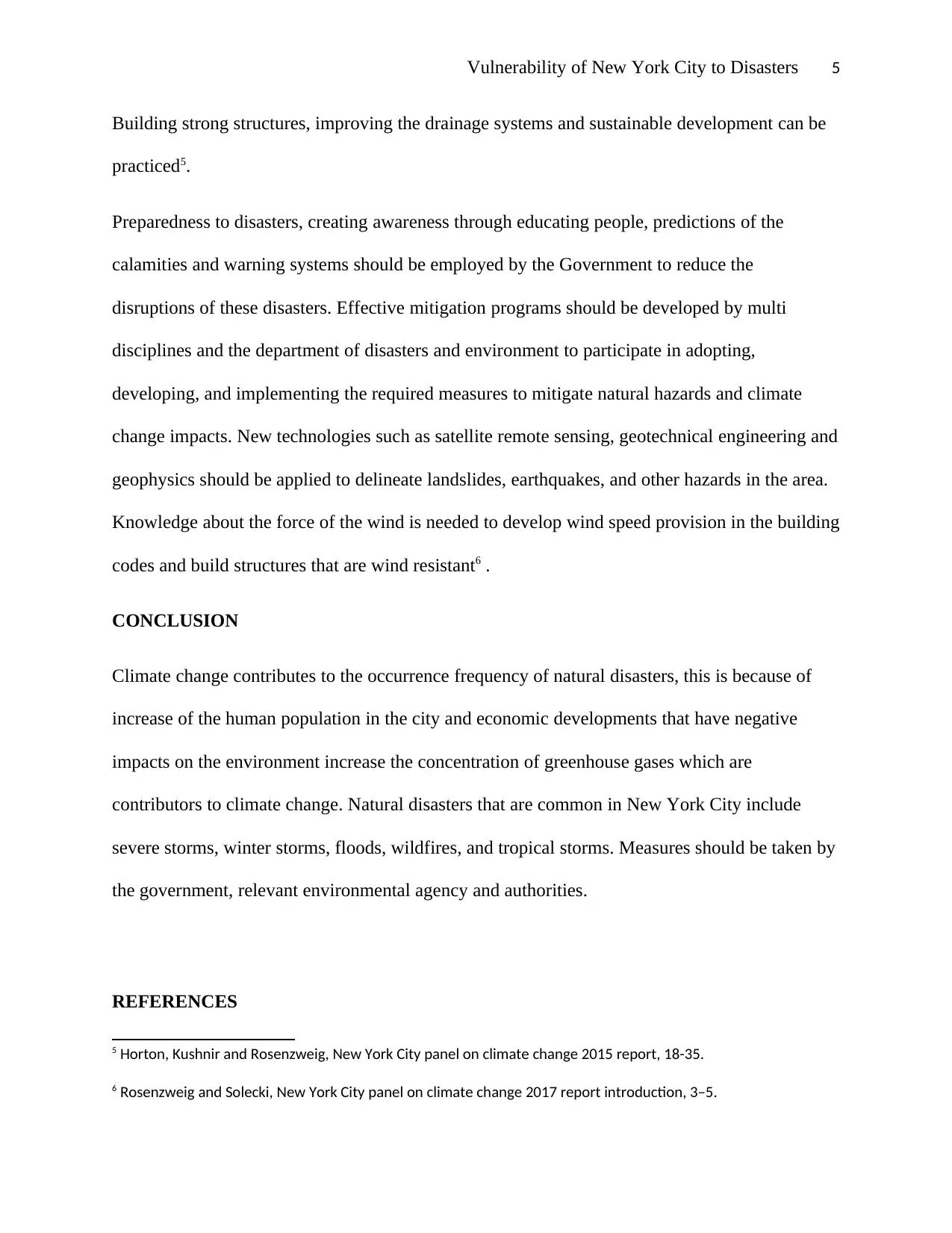
Vulnerability of New York City to Disasters 5
Building strong structures, improving the drainage systems and sustainable development can be
practiced5.
Preparedness to disasters, creating awareness through educating people, predictions of the
calamities and warning systems should be employed by the Government to reduce the
disruptions of these disasters. Effective mitigation programs should be developed by multi
disciplines and the department of disasters and environment to participate in adopting,
developing, and implementing the required measures to mitigate natural hazards and climate
change impacts. New technologies such as satellite remote sensing, geotechnical engineering and
geophysics should be applied to delineate landslides, earthquakes, and other hazards in the area.
Knowledge about the force of the wind is needed to develop wind speed provision in the building
codes and build structures that are wind resistant6 .
CONCLUSION
Climate change contributes to the occurrence frequency of natural disasters, this is because of
increase of the human population in the city and economic developments that have negative
impacts on the environment increase the concentration of greenhouse gases which are
contributors to climate change. Natural disasters that are common in New York City include
severe storms, winter storms, floods, wildfires, and tropical storms. Measures should be taken by
the government, relevant environmental agency and authorities.
REFERENCES
5 Horton, Kushnir and Rosenzweig, New York City panel on climate change 2015 report, 18-35.
6 Rosenzweig and Solecki, New York City panel on climate change 2017 report introduction, 3–5.
Building strong structures, improving the drainage systems and sustainable development can be
practiced5.
Preparedness to disasters, creating awareness through educating people, predictions of the
calamities and warning systems should be employed by the Government to reduce the
disruptions of these disasters. Effective mitigation programs should be developed by multi
disciplines and the department of disasters and environment to participate in adopting,
developing, and implementing the required measures to mitigate natural hazards and climate
change impacts. New technologies such as satellite remote sensing, geotechnical engineering and
geophysics should be applied to delineate landslides, earthquakes, and other hazards in the area.
Knowledge about the force of the wind is needed to develop wind speed provision in the building
codes and build structures that are wind resistant6 .
CONCLUSION
Climate change contributes to the occurrence frequency of natural disasters, this is because of
increase of the human population in the city and economic developments that have negative
impacts on the environment increase the concentration of greenhouse gases which are
contributors to climate change. Natural disasters that are common in New York City include
severe storms, winter storms, floods, wildfires, and tropical storms. Measures should be taken by
the government, relevant environmental agency and authorities.
REFERENCES
5 Horton, Kushnir and Rosenzweig, New York City panel on climate change 2015 report, 18-35.
6 Rosenzweig and Solecki, New York City panel on climate change 2017 report introduction, 3–5.
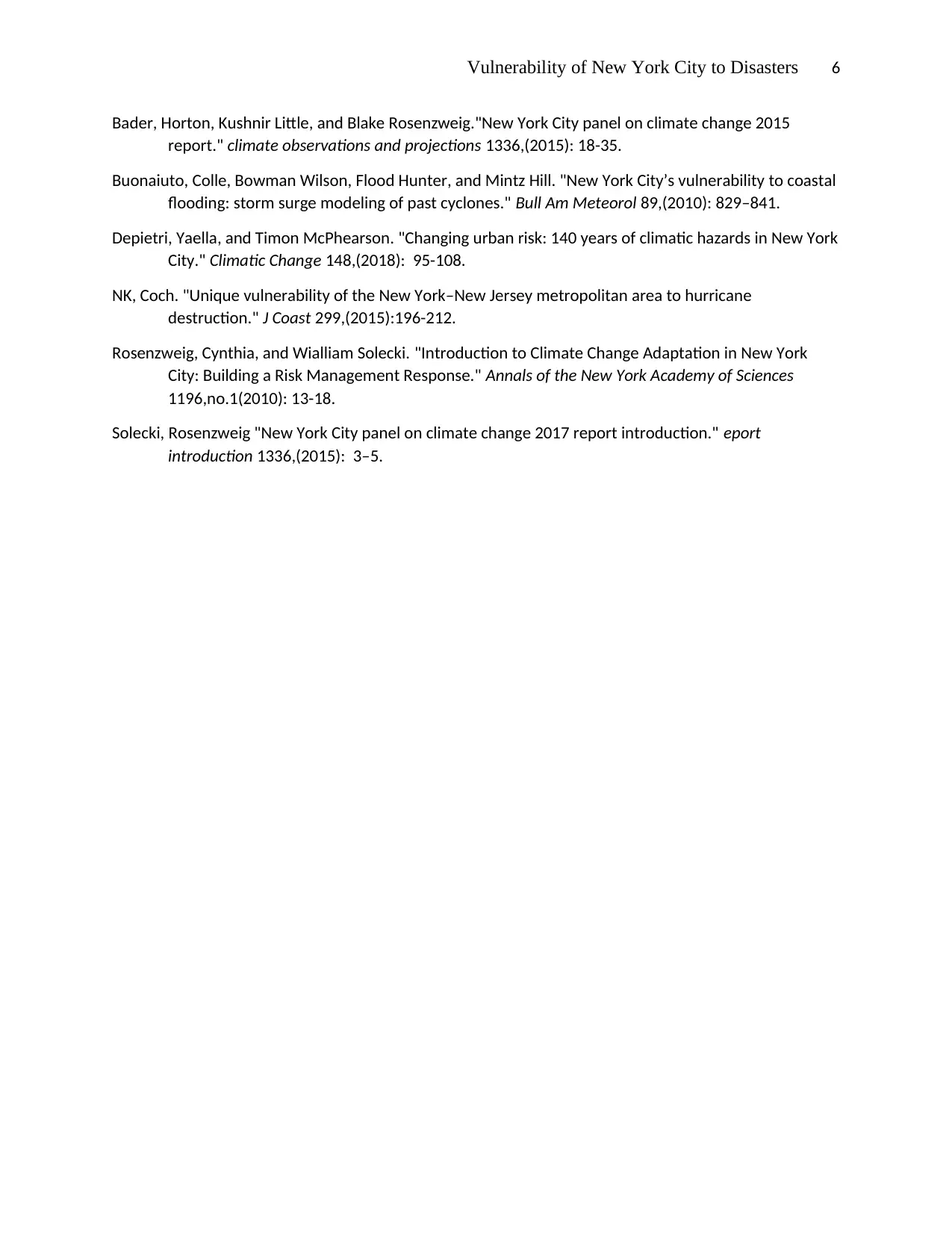
Vulnerability of New York City to Disasters 6
Bader, Horton, Kushnir Little, and Blake Rosenzweig."New York City panel on climate change 2015
report." climate observations and projections 1336,(2015): 18-35.
Buonaiuto, Colle, Bowman Wilson, Flood Hunter, and Mintz Hill. "New York City’s vulnerability to coastal
flooding: storm surge modeling of past cyclones." Bull Am Meteorol 89,(2010): 829–841.
Depietri, Yaella, and Timon McPhearson. "Changing urban risk: 140 years of climatic hazards in New York
City." Climatic Change 148,(2018): 95-108.
NK, Coch. "Unique vulnerability of the New York–New Jersey metropolitan area to hurricane
destruction." J Coast 299,(2015):196-212.
Rosenzweig, Cynthia, and Wialliam Solecki. "Introduction to Climate Change Adaptation in New York
City: Building a Risk Management Response." Annals of the New York Academy of Sciences
1196,no.1(2010): 13-18.
Solecki, Rosenzweig "New York City panel on climate change 2017 report introduction." eport
introduction 1336,(2015): 3–5.
Bader, Horton, Kushnir Little, and Blake Rosenzweig."New York City panel on climate change 2015
report." climate observations and projections 1336,(2015): 18-35.
Buonaiuto, Colle, Bowman Wilson, Flood Hunter, and Mintz Hill. "New York City’s vulnerability to coastal
flooding: storm surge modeling of past cyclones." Bull Am Meteorol 89,(2010): 829–841.
Depietri, Yaella, and Timon McPhearson. "Changing urban risk: 140 years of climatic hazards in New York
City." Climatic Change 148,(2018): 95-108.
NK, Coch. "Unique vulnerability of the New York–New Jersey metropolitan area to hurricane
destruction." J Coast 299,(2015):196-212.
Rosenzweig, Cynthia, and Wialliam Solecki. "Introduction to Climate Change Adaptation in New York
City: Building a Risk Management Response." Annals of the New York Academy of Sciences
1196,no.1(2010): 13-18.
Solecki, Rosenzweig "New York City panel on climate change 2017 report introduction." eport
introduction 1336,(2015): 3–5.
⊘ This is a preview!⊘
Do you want full access?
Subscribe today to unlock all pages.

Trusted by 1+ million students worldwide
1 out of 6
Related Documents
Your All-in-One AI-Powered Toolkit for Academic Success.
+13062052269
info@desklib.com
Available 24*7 on WhatsApp / Email
![[object Object]](/_next/static/media/star-bottom.7253800d.svg)
Unlock your academic potential
Copyright © 2020–2025 A2Z Services. All Rights Reserved. Developed and managed by ZUCOL.





